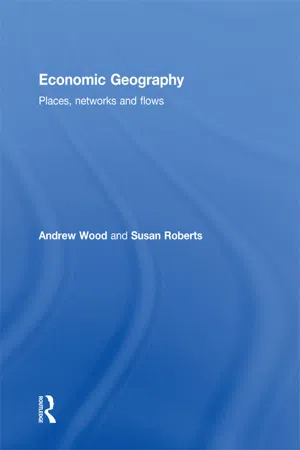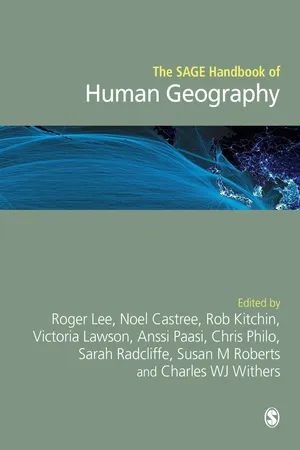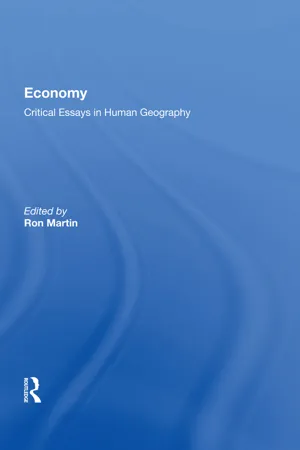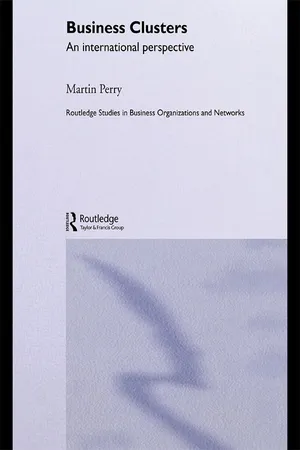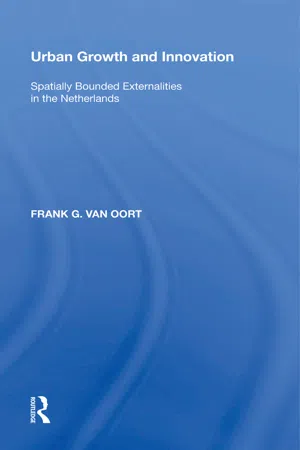Geography
Economic Geography
Economic geography is the study of how economic activities are organized and distributed across different locations. It examines the spatial patterns of production, consumption, and exchange, as well as the factors that influence these patterns, such as resources, technology, and government policies. This field also explores the impacts of globalization, trade, and urbanization on economic landscapes.
Written by Perlego with AI-assistance
Related key terms
10 Key excerpts on "Economic Geography"
- eBook - ePub
Economic Geography
A Critical Introduction
- Trevor J. Barnes, Brett Christophers(Authors)
- 2017(Publication Date)
- Wiley-Blackwell(Publisher)
emphasizes that geography matters, knowing others are less wont to do so.This notion of the “materiality of geography” is what we refer to as the implication of space, place, scale, landscape, and environment in economic processes. By “implicated” we mean that the geographies in question affect the processes in question. Whether it is inflation, globalization, raw material extraction, industrial waste disposal, or whatever else, geography is integral rather than peripheral or incidental to the form and outcomes of the process. It is an active ingredient. We add the word “substantive” to make a key further point. This is, that the effects of the geographic are not trivial or marginal. They are significant to the degree of being necessary to explanation. Or, to look at things from an alternative perspective, one might say that the form and outcomes of economic processes in which space and other factors are substantively implicated would be significantly different were it not for those factors. Geography makes a (big) difference. As such, meaningful understanding and explanation of such processes requires explicit attention to and consideration of their geographical dimensions.This leaves just one final component of our definition to be elucidated: the nature of the “space, place, scale, landscape, and environment” upon the implications of which Economic Geography focuses. What are these things? This question, unsurprisingly, has no simple answer beyond saying that they constitute collectively the essential “stuff” of human geography. Probably at least as much ink has been spilled on each such concept and its meaning as on “economy.”At this point we provide no attempt at definitions or identification of general usages of these terms in Economic Geography. Definitions would be impossible. And usage in Economic Geography is in many respects what this book as a whole is about. The meaning of a term like “place” only really becomes apparent and consequential in the context of its utilization. How Economic Geography understands and invokes each key geographic term will become clearer in the following chapters. For now, therefore, we limit ourselves to a preliminary sketch of each term’s basic contours, which we think is a helpful foundation from which to proceed (Box 2.2 - eBook - ePub
Economic Geography
Places, Networks and Flows
- Andrew Wood, Susan Roberts(Authors)
- 2012(Publication Date)
- Routledge(Publisher)
PART I
TRADITIONAL ECONOMIC GEOGRAPHIES
Economic Geography is a broad and diverse field. Today, a significant number of economic geographers, regional scientists, planners and economists continue to work with and refine concepts drawn from what we are labeling ‘traditional Economic Geography.’ Traditional Economic Geography not only has deep roots but continues to develop and evolve. However, it should be pointed out that many economic geographers (and other social scientists too) deliberately ignore traditional Economic Geography on the grounds that they are not motivated by the same sorts of questions traditional Economic Geography asks, they do not use the same sorts of methods it favors, and they have different understandings of the broader social and political roles of Economic Geography.So, what are the hallmarks of traditional Economic Geography? First, there is an abiding commitment to rationalism. By this we mean that traditional Economic Geography is based on assumptions that the world can be known through observation and that it is fundamentally an ordered word. That is, that there are regularities and patterns that need to be identified and explained by the economic geographer. Further, the world's orderliness, including its spatial patterning, is itself the outcome of orderly economic processes, treated in many accounts as laws of economic activity. Orderly economic patterns and processes, in traditional Economic Geography, are seen as the outcome of rational decisions made by economic actors; typically individuals and firms. These rationalist underpinnings have come in for considerable skepticism and criticism, as Trevor Barnes has detailed in his writings on the history of ideas in Economic Geography (1996, 2000). However, the powerful discipline of economics is very much based on these foundations, as is much so-called common-sense understanding of the market or the economy, so it is not surprising that the approaches of traditional Economic Geography continue to attract many and, as Paul Plummer indicates, they most definitely have not been ‘consigned to the dustbin of intellectual history’ (Plummer 2000: 28). Indeed, it could be argued that through the attention given to geographical questions by such prominent economists as Paul Krugman, traditional Economic Geography approaches have been reinvigorated in the past decade or so. Certainly, a major methodological goal of traditional Economic Geography and of economics, ‘being able to produce tightly specified models’ (Krugman 2000: 59), continues to exercise many. - Gary Cook, Jennifer Johns, Frank McDonald, Jonathan Beaverstock, Naresh Pandit(Authors)
- 2018(Publication Date)
- Routledge(Publisher)
p.175 PART III The interface between Economic Geography and International Business p.177 11 Economic Geography AND INTERNATIONAL BUSINESS Henry Wai-chung Yeung Introduction The development and emergence of economic-geographical studies of International Business activities is an important topic. As these cross-border intra- and inter-firm activities are becoming more globally interconnected and interdependent today, their management and governance by firms, states and other institutions is much more challenging and complex. The geographical foundations and specificities of this phenomenon in a globalizing era has become a crucial research question for the academic fields of Economic Geography and International Business studies. Indeed, both fields are nested within the larger disciplines – respectively in human geography and in strategy and management studies. Both fields are primarily concerned with descriptions and explanations of real-world economic phenomena in the world. There is thus much commonality between Economic Geography and International Business studies. In this chapter, I focus on two key issues that speak well to the interface between Economic Geography and International Business studies: (1) the geographical nature of International Business and (2) the theorization of spatiality in International Business studies. The first issue is fairly obvious in a global economy characterized by densely interconnected networks of firms and economies operating at different geographical scales. In short, there are clearly visible geographical foundations to International Business activities (Yeung, 2005a, 2009a). While the role of physical location and distance has been conceptualized in some leading theoretical perspectives in International Business studies (e.g. Dunning, 1998, 2009; Buckley & Ghauri, 2004), the nature of spatiality entails much more than location as a production factor, an agglomeration economy, or a competitive advantage- eBook - ePub
- Cynthia Metcalf, Rhonda Atkinson(Authors)
- 2017(Publication Date)
- Research & Education Association(Publisher)
Human Geography focuses on humans and the cultures they create relative to their space. It encompasses population geography, economics, and political geography and looks at how people’s activities relate to the environment politically, culturally, historically, and socially.Physical Geography addresses Earth’s physical environment: water (hydrosphere ), air (atmosphere ), plants and animals (biosphere ), and land (lithosphere ). Physical geographers study land formation, water, weather, and climate (weather patterns, specifically precipitation and temperature, over time), as well as more specific topics such as geomorphology, biogeography, and environmental geography.Regional Geography organizes areas of Earth that have some degree of similarity and divides the world into different realms .Topical/Systemic Geography is the orderly and methodical study of climate, landforms, economics, and culture.The main focus of geographers, no matter the subfield, is the spatial perspective. For example, population geography deals with the relationships between geography and population patterns, including birth and death rates. Political geography concerns the effect of geography on politics, especially on national boundaries and relations between states. Economic Geography focuses on the interaction between Earth’s landscape and the economic activity of the human population.COMPETENCY 1.1Apply the six essential elements of geography. Geographic Education: 18 Standards, 6 ElementsThe National Geography Standards(http://nationalgeographic.org/standards/national-geography-standards/ - eBook - ePub
- Roger Lee, Noel Castree, Rob Kitchin, Vicky Lawson, Anssi Paasi, Chris Philo, Sarah Radcliffe, Susan M. Roberts, Charles Withers(Authors)
- 2014(Publication Date)
- SAGE Publications Ltd(Publisher)
Insofar as Economic Geography captures or reflects the economy, it is a diverse place where the motivations, motions, and direction of individual elements and actors are less the product of an internal logic or structure and more a product of context and contingency. The economy, to the degree it is a site to be comprehended as a singularity, is inextricably linked to (and constituted by) other processes, which are generally excluded from consideration by economics. Culture and society, gender and identity, bodies and places, as well as the material processes of the environment, technology, and administration all constitute the economy that is performed by Economic Geography. Even where economic geographers focus on and theorize capitalism per se, it is a ‘variegated’ capitalism (Peck and Theodore 2007) that is differentiated across space and whose contours and trajectories are a function of myriad other processes and practices (e.g. social context, power, relations and networks, identities, gender, culture, race, sexuality, etc.). Economic Geography disrupts many of the assumed attributes and dynamics that we normally associate with the economy and, indeed, with capitalism. Its capacities and propensities are no longer seen as inevitable law-like functions but, via the empirical and theoretical work of human geographers, as outcomes of rich contexts and multiple determinants as increasingly evident, even in the work of geographers concerned with economic modeling (see, for example, the discussion in Martin and Sunley, 2010).Furthermore, human geographers not only work on capitalism such that it becomes other than what it was assumed to be (e.g. variegated, embedded, and contingent), they also expand the field of economics to sites and practices outside the capitalist frame. Again, at an ontological level, we see in Economic Geography a wide range of sites, which, from the perspective of orthodox economics, are thought to be outside the economy (as we have noted in our Introduction, the list of such ‘outsiders’ is open-ended). These do not just affect or condition some external economy; they themselves are sites of economic practice and, often, alternative economic performance (Leyshon, Lee, and Williams, 2003; Lee, 2006; Fuller, Jonas, and Lee 2010, also see the following). It is not that economists do not also explore these ‘margins’, but that within economics they are peripheral to a set of core concepts and theories which align with the economy. In Economic Geography, however, they appear as no more or less vital than other more traditional sites of economy (e.g. firm, etc.).The ontological diversity presumed and produced by Economic Geography is, we posit, a product of its epistemological and theoretical diversity, its heterodoxy (cf. St Martin and Wing, 2007). Theoretical explorations and influences that have been felt across the social sciences and have been incorporated and institutionalized within Economic Geography, such as how one might know the economy and, indeed, how one might perform it, have been multiplied. Whereas in economics, for example, such influences produced an academic culture of division, orthodoxy and dissention, and marginalization of theoretical (and hence economic) difference, in Economic Geography it resulted in a decidedly more hybridized and open academic milieu. Indeed, this is what makes Economic Geography distinct from economics, it is a site where a wealth of ontological and epistemological difference relative to economy has proliferated and multiplied, thereby allowing different economic worlds to also proliferate and multiply. - Jean-Claude Prager, Jacques-François Thisse(Authors)
- 2012(Publication Date)
- Routledge(Publisher)
2 Economic Geography
Facts and theories
The shaping of the space-economy
High population density fosters the division of labor
What are the main geographical forces that affect the economic and social development of a given region or country? The first was identified by Adam Smith more than two centuries ago: “the extent of the division of labor is limited by the size of the market.” The market is defined here as the range of customers that producers can supply through existing transport technologies. This suggests that the high population density prevailing in cities allows a degree of task specialization that is not found in rural areas, since such density ensures that there will be outlets to support local craftsmen and workshops. To a large extent, city dwellers produce neither the food they eat nor the energy they consume. In exchange for the farm products and energy they need, they must therefore supply goods and services that are not produced in rural areas. The production of such commodities requires greater task specialization than is typically found in the countryside.In addition, a city is its own primary outlet, since the inhabitants consume a high proportion of the goods and services produced there. In other words, the city itself is the main component of its market. This observation is relevant because most services are by nature non-transportable and must be consumed where they are produced. Since the export base often accounts for only a small share of a city’s activities, local services are a crucial factor in urban growth.To justify acquisition of the skills required for such task specialization, cities and their hinterlands must therefore be of a certain size. To put it simply, a sufficiently large and relatively concentrated population is needed. Once this condition has been met, a finer division of labor generates an urban surplus that can be shipped to the city’s rural hinterland and sometimes to other cities specializing in the production of different goods. The combination of these two forces generates surpluses of various natures and origins, which in turn are traded between the rural and urban populations. In most cases, this process has been slow because it is subject to many contingencies: these surpluses leave the subsistence economy and enter the trade economy, which requires much more complex institutions than those of the rural community, especially the use of money.- eBook - ePub
Economic Development and Inequality in China
The Case of Guangdong
- Hong Yu(Author)
- 2017(Publication Date)
- Routledge(Publisher)
Part I Literature review framework of Economic GeographyPassage contains an image
2 Theoretical framework I Economic Geography This chapter offers a critical discussion of the theories of Economic Geography; it attempts to provide a general estimation of their importance to regional development and spatial economic inequality. In precise terms, what are the contributions of geographical location and proximity to markets to the unbalanced development between the core and peripheral regions? How important are favourable coastal location and market proximity to the creation of spatial disparity and unequal economic distribution?TheoriesLösch is perhaps one of the earliest renowned contributors to Economic Geography. Lösch (1954) highlighted the dominance of transportation costs in geography theory. In terms of private enterprises, he pointed out that long distances tend to increase time, transportation and other costs in manufacturing production. Economic Geography theories suggest that geographical location has a major effect on regional economic growth and spatial industrial distribution via transportation costs. Brakman et al. (2001) maintain that transportation costs play a central role in Economic Geography theory and ref ect regional geographical differences. The prospect of minimizing transportation costs tends to attract firms to coasta locations or regions with large markets. Differences of geographical location and transportation costs thus account for varying levels of regional economic development, for example the sharp economic disparity between China’s coastal and inland regions. As Overman et al. (2003: 2) state, ‘distance directly increases transaction costs because of basic shipping costs, the time cost of shipping date sensitive products, the costs of contracting at a distance, and the costs of acquiring information about remote economies’. Beckmann et al - eBook - ePub
Economy
Critical Essays in Human Geography
- Ron Martin(Author)
- 2017(Publication Date)
- Routledge(Publisher)
Reflecting on these debates, I identify six axioms that are central to conceptualizing economic geographies. I then go on to consider issues of culture and the economy and the relationships between them. The paper explores the links between political-economic and cultural-economic approaches, suggesting that they are most productively seen as complementary both/and approaches rather than as competitive either/or ones. Key words: economic geographies, circuits, flows, spaces, capitalism, political economy, cultural economy I Introduction The last decade or so has been one of ongoing, at times heated, debate in Economic Geography as to how best to conceptualize and theorize economies and their geographies, and, relatedly, how best to practise and carry out research on such economic geographies. This debate is reflected in a number of edited volumes that seek to define the current state-of-the-art and (re)define the conceptual boundaries of Economic Geography (for example, see Amin and Thrift, 2004b; Clark et al, 2000; Lee and Wills, 1997; Sheppard and Barnes, 2000). During the 1970s and 1980s, in the wake of the critique of spatial science and views of the space economy that drew heavily on the orthodoxies of neoclassical economics, strands of heterodox political-economic approaches in general and Marxian political economy in particular rose to prominence. These were important in introducing concerns with issues of evolution, institutions and the state, alongside those of agency and structure, in seeking to develop more powerful and nuanced understandings of economies and their geographies. Much of the subsequent debate in the 1990s has been informed by poststructural critiques of such political-economic approaches, especially those that were seen (rightly or wrongly) to rely upon an overly deterministic and structural reading of the economy and its geographies (Hudson, 2001) - eBook - ePub
- Martin Perry(Author)
- 2005(Publication Date)
- Routledge(Publisher)
A bipolar distribution of firms within industries, with a few accounting for most production, does not fit with the firm assumptions of new Economic Geography. Large organizations have more capacity and reason to sustain a dispersed geography of production than the small, monopolistic competitors. Establishing branch plants and subsidiaries makes possible the diffusion of technology to equalize productivity differences between places. Strategically there may be advantage in maintaining production in multiple locations, for example to reduce labour power and reduce risks to the security of production. Practically, the emergence of large organizations through mergers and acquisitions are likely to create organizations with dispersed and idiosyncratic geographies of production. In contrast, the patterns of specialization predicted in new Economic Geography are based on internal economies of scale increasing the incentive for firms to concentrate on one site.The comparison between Europe and the USA can also be used to draw attention to the role of immobile factors of production, especially physical space. Judged by land availability and land-use regulation, physical space is generally more of a constraint on economic activity in Europe than North America. Land constraints are recognized by new economic geographers as a potential centrifugal force but they do not form part of the core model. In the UK, for example, an inverse relationship between the degree of urbanization of a region and its manufacturing employment growth has long been apparent (Fothergill and Gudgin 1982). One interpretation of this trend indicates that the lack of space within established urban areas has encouraged employment growth to concentrate in newer industrial areas (Fothergill et al. 1985). The urban-rural shift was particularly pronounced in the UK but it has been an aspect of mature urban systems that needs consideration in the explanation of changing location patterns.Conclusion
To date, new Economic Geography provides no clear endorsement for the emergence of business clusters as an aspect of competitive industrial economies. As one prominent new economic geographer has put it, this branch of economics is still in the Wright Brothers’ phase of learning how to fly (Fujita cited in Stelder 2002). The core model built by Krugman (1991a) remains the main guide as to the direction of future flight. As with any model building, the complexity of economic life is reduced to a small number of variables and processes. In Krugman’s view, the existence of gaps and emphasis on some variables at the expense of others is not a grave problem or serious limitation. The role of a model is to capture the core of real-world patterns. If it proves inadequate in this task, there is opportunity to modify the assumptions and vary the mix of variables. On this basis, it may be unfair to focus on the content of the initial model especially given the extensions and modifications that are being made (Brakman et al. - eBook - ePub
Urban Growth and Innovation
Spatially Bounded Externalities in the Netherlands
- Frank G. van Oort(Author)
- 2017(Publication Date)
- Routledge(Publisher)
Chapter 2 Agglomeration in Economic and Geographical Theories 2.1 Introduction The Resurgence of Agglomeration Economies as a Fuzzy Concept? 1 The wealth of nations is not evenly spread among its regions and within regions among locations. It would be better to speak of wealth of regions and locations instead (Porter 1998). But what exactly fosters the competitive advantage of nations, regions, cities and locations? Much of the current debate in the economic and geographical literature is focused on the determination of explaining static and dynamic circumstances for this stylized fact 2. Especially since the early 1980s the spatial configuration of the economy became of interest in mainstream western social science, including political scientists, sociologists, economists and geographers. For some, this interest was considered renewed because long traditions already exist on spatial (aspects of) analysis in their respective disciplines (Storper 1997). A central theme in this 'resurgence' of geographical thought concerns the revived value attached to the concept of agglomeration economies. This is the element most perceived as stylized fact, because clustering of population and economic activity in cities and regions is among the most common observations in every society. Discussions though exist on the exact substance and (economic) mechanisms behind these agglomeration forces. The notion of economic agglomeration has only to limited degree been perceived as a crucial factor in geographical and economic theory. And the renewed recent attention on the spatial dimension of economic activity in the mainstream literatures does not unambiguously clarify important conceptual difficulties in the agglomeration discussions (yet). Especially spatial conceptualization remains scattered and therefore often fuzzy in character (Parr 2002)
Learn about this page
Index pages curate the most relevant extracts from our library of academic textbooks. They’ve been created using an in-house natural language model (NLM), each adding context and meaning to key research topics.

